Back to Blog
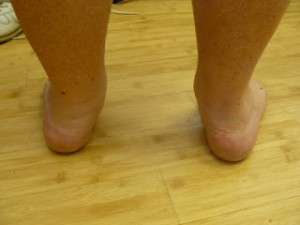
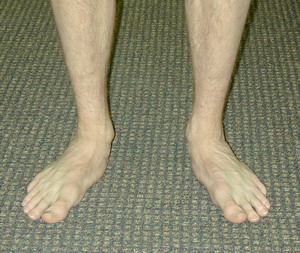
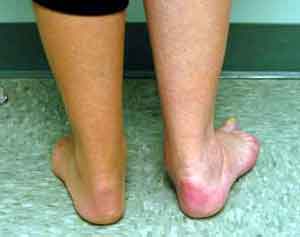
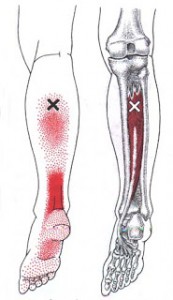
Away with the flat feet! AAF Beware! – Adult Aquired Flatfoot (AAF) and Posterior Tibialis Tendon Dysfunction (PTTD)
Adult Acquired Flatfoot – aka AAF – is a deformity of the foot and is a result of a number of different pathologies. In practice, the most common reason for the development of AAF is Posterior Tibialis Tendon Dysfunction (PTTD). We’re done with the abbreviations for now…
Bilateral Posterior View

Bilateral Anterior View

Unilateral (R) Posterior View

AAF is a technical way of saying that over time, your arches have collapsed. This can lead to significant pain in the foot, but because of the position the ankle is held it can also contribute to knee hip and low back pain. The foot being in a fallen arch position also leads to further degeneration of the joints of the foot and can make simple walking very uncomfortable.
PTTD is one of a number of ways to progress into AAF. The posterior tibialis muscle holds up the longitudinal arch of the foot, stabilizes the midfoot, and plantarflexes/inverts the foot. This tendon/muscle can become damaged with high-impact sports of jumping/landing/running (basketball, soccer – made worse by the fact that there is absolutely no support in soccer shoes!). Other risk factors for development include being a woman over the age of 40, previous injuries to the ankle, diabetes and high blood pressure. Obesity is also a huge contributing factor (no pun intended?).

Predominantly, PTTD is treated with custom foot orthoses or ankle-foot orthoses along with a stretch and strengthening routine. This treatment regime was substantiated by a number of articles that were released and published by Kulig from the University of Southern California (Physical Therapy), one being: Nonsurgical management of posterior tibial tendon dysfunction with orthoses and resistive exercise: a randomized controlled trial published in 2008. It described a 12 week program comparing three categories of regimes: orthotic wear with stretching (1), orthotic wear with stretching and concentric exercise (2), and orthotic wear with stretching and eccentric exercise (3). Best outcomes came from the third group – the orthotic/stretch/eccentrics.
So how to we train the posterior tibialis muscle/tendon? Finally the meat and potatoes! Kulig is rampant with the research, and published another paper describing firing patterns of different muscles of the foot/ankle with different resisted movements. She found that the resisted movement that engaged the posterior tibialis muscle maximally without significant contribution of other foot muscles was planted foot adduction.
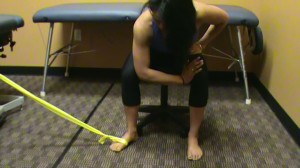
You can see that she is seated (the knee has to be at 90 degrees to allow rotational motion at the knee joint) and that her heel remains in contact with the floor at all times. Concentration is emphasized on slowly releasing the elastic from an adducted position. This being an endurance muscle, we will train it as such: 3-4 sets of 20 reps.
Another great isolation exercise to add into the rehab of clients requiring it!
References:
Kulig, K et al. (2004). Selective Activation of Tibialis Posterior: Evaluation by Magnetic Resonance Imaging. Medicine & Science in Sports & Exercising, 36(5), 862-7.
Kulig, K et al. (2006). Non-operative management of posterior tibialis tendon dysfunction: design of a randomized clinical trial. BMC Musculoskeletal Disorders, 7(49), 1-7.

